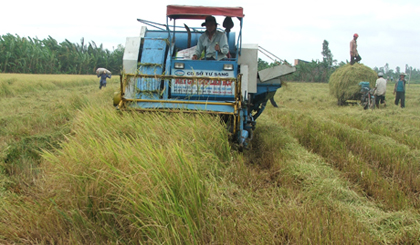Changing production and overcoming the consequences of natural disasters in Go Cong fresh water area
In 2016, Go Cong freshwater area includes Go Cong, Cho Gao, Go Cong Tay, Go Cong Dong districts and Go Cong town have many influences of drought and saltwater intrusion. 4,000 hectares of winter-spring rice crop were damaged in the entire area; tens of thousands of residents living along the rivers and the sea, outside the dyke, etc. lack water for daily use severely. The total damage caused by natural disasters is estimated hundreds of billions VND.
According to Mr. Nguyen Hoang Viet, Vice Chairman of People's Committee of Go Cong Dong district, toward the risk of natural disasters, the district has proposed a reasonable solution to convert crops and livestock in coastal areas, taking effect on a stable economy. By converting farm produce into paddy field where is facing the worst drought and saltwater intrusion; expanding livestock and poultry and building economic models in the farmer households according to the modes of VAC and VACR, etc.
Currently, the whole district has about 150 ha per crop for farm produce, which brings higher incomes than rice monoculture from VND20-30 million/ha/year. The district formed large gathering area of farm produce in Binh Nghi, Tan Tay, Tan Dong, Tan Dien and Tan Thanh communes. In coastal areas of Tan Thanh, Tan Dien, Hoa, etc., breeding cows, goats, and brackish and salty water aquaculture are developed.
Mr. Doan Van Hong, a farmer at Tang Hoa commune, Go Cong Dong district, a volunteer in breeding cross-bred goats to adapt to the climate change which helps him get a great achievement, said that his family has 5,000 m2 of arable land. Through researching and learning models of production, from 2002, he chose to breed goat for a stable economy. After 14 years, he has had 105 cross-bred goats, of which 75 nanny goats are breeders, and the rest are billy-goats and meat goats. Per year, his family gets the profit over VND250 million.
 |
| Photo for Illustration (Pho to: Thai Thien). |
Go Cong Tay district, where covers approximately 15,000 hectares of arable land, was converted production towards reducing rice acreage, increasing the area of other suitable crops, built efficiently work-models, mobilized human resources to give a hand in adapting climate change.
According to Mr. Tran Hoang Nhat Nam, Vice Chairman of People's Committee of the district, the planning of the locality to 2020 is reducing rice cultivation acreage of 3 crops in 10,000 ha, expanding the area of farm produce of about 2,700 ha, notably there are 400 ha specialized in cultivating farm produce, and some rotation crops in rice filed, the rest is planted fruit orchards. The district has planned production areas such as rice-growing areas are in the freshwater dykes of 12 communes and towns; vegetable-growing areas are concentrated in the communes of Binh Nhi, Vinh Long, Vinh Huu, Long Binh, Binh Tan, etc.; fruit areas in Dong Son, Binh Phu and Binh Tan communes, etc.
Thereby, the district has many new converting models which bring good economic efficiency: taro growing in rice fields of farmer Phan Ngoc Luan, at Binh Hung hamlet, Vinh Binh town. Vinh Binh town is a low-lying area, far away from Xuan Hoa cannel which is the primary water supply of Go Cong fresh water zone program, so it is often flooded in the rainy season, but drought and water shortage in the dry season. For many years, Mr. Luan bravely transformed from cultivating high-yield rice with 3 crops every year to taro in an area of 1 ha.
Averagely, with 1,000 m2, the cost is about VND7.5 million. The average output of taro would reach 20 tons/ha with the price 13,000 VND/kg, total revenue is 26 million, of which net profit is VND18.5 million per 1,000 m2. According to the transaction, the net profit of every hectare of taro cultivation is VND185 million. The profit of taro is higher than that of high-yield rice about 3-4 times.
According to Dr. Tran Thanh Phong, Director of Provincial Agricultural Extension Center, annually, the center builds about 20 production models including rice intensification, production with big field model and conversion of plant on the rice land. It organizes 150 training courses, workshops and tours for local farmers to popularize technical advances, new models and ways to work efficiently, etc. so that they can apply and replicate together.
Especially, for intensive vegetable growing areas in Go Cong Tay, Go Cong Dong districts and Go Cong town, the center has delivered VietGAP process and help 4 agencies and 153 farmers with more than 31 ha of vegetable accredited to reach VietGAP criteria. Currently, the agencies have signed contracts for stable product consumption at 2-3 tons/day/agency. Thereby, it contributes to stabilizing production in conditions of disaster, drought and salinity, and helps farmers to get more profit about VND50 million/ha/year in comparison with monoculture rice.
(Source: www.tiengiang.gov.vn)
 về đầu trang
về đầu trang






